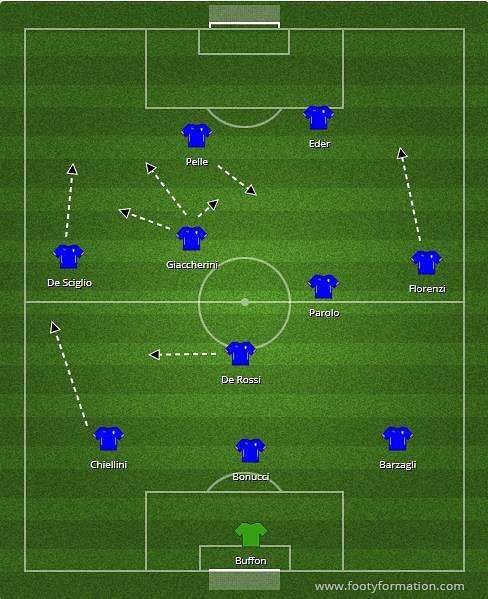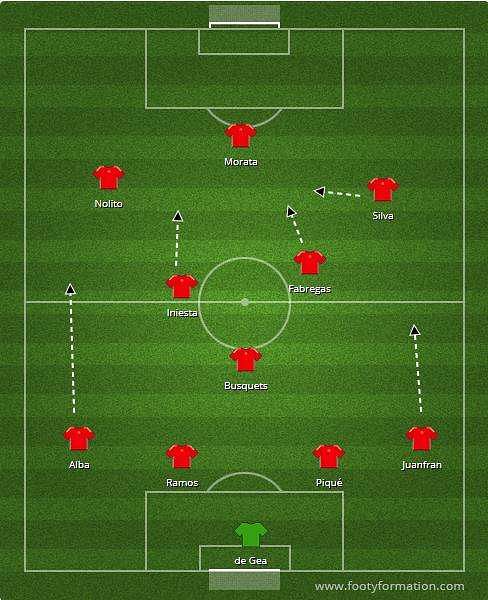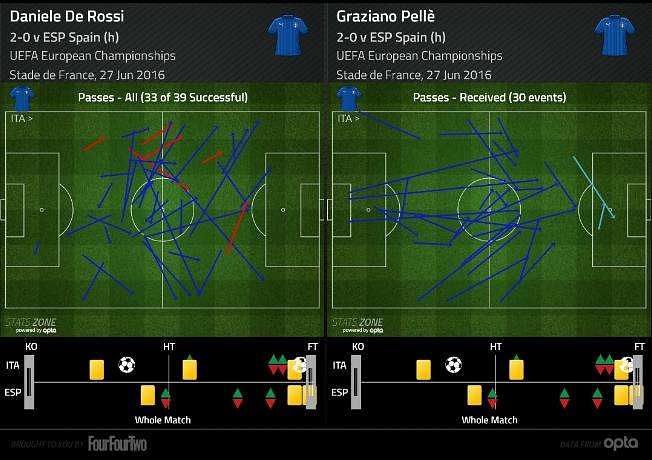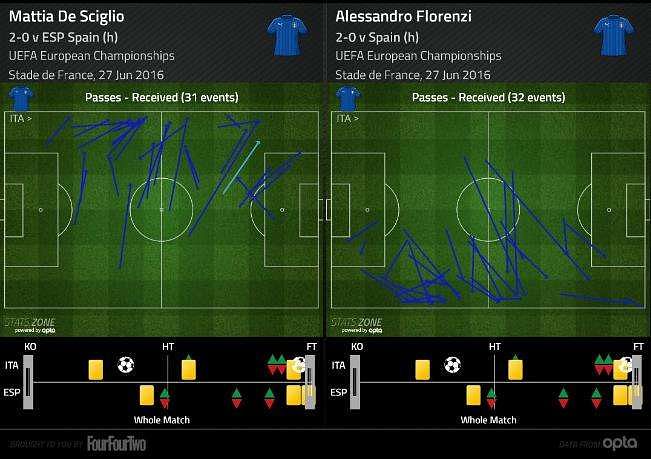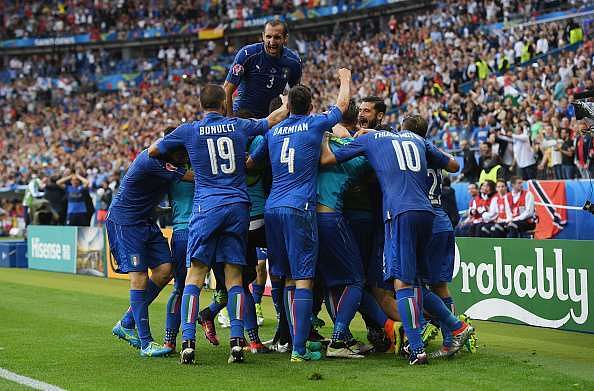
Euro 2016: Italy 2-0 Spain - In depth tactical analysis of how Antonio Conte's side delivered a performance for the ages
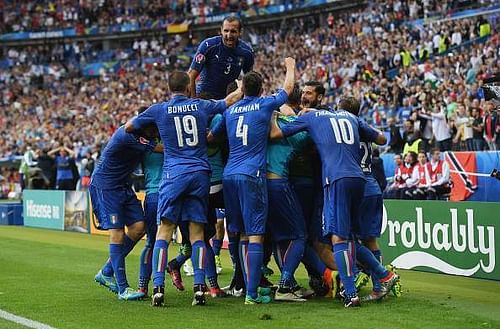
In one of the most absorbing games of Euro 2016, Italy prevailed over Spain in what was an intense tactical battle that saw Antonio Conte's side knock out the holders. Italy had won just once against Spain in their last 11 meetings having lost 4-0 in the final in 2012, but there were no suggestions of an inferiority complex with the Italians dominating the first half before seeing out the second with relative comfort.
The former Juventus manager went with his favoured 3-5-2 with Alessandro Florenzi starting instead of the injured Antonio Candreva. Having rested players in the final group game loss to the Republic of Ireland, he was able to bring back his key men fresh for this blockbuster of a game.
Vicente Del Bosque, on the other hand, named the same line-up for the fourth game running and having looked slightly jaded in the second half against Croatia, the fitness levels his players was always going to play a big part.
Conte had flared up at suggestions that his side were going to sit deep and look to counter. “All I keep hearing is defend, defend, defend. Pay attention to Nolito. Pay attention to Morata. Pay attention to Iniesta,” he said. “But they will have to pay attention to us.” As it turned out, Spain should have heeded his advice.
Before the game, Xavi had pointed out that Spain struggled to press high when facing teams who play three at the back. It was apparent against Italy in the group stage of Euro 2012, and in the last World Cup against Netherlands and Chile.
Italy’s 3-5-2 turns into a flexible 3-4-3 while going forward with the two wingbacks pushing up and morphs into a 3-5-2/4-4-2 without the ball with the ball near wingback getting in line with central defenders and the wide midfielder, either Giaccherini or Parolo, taking a position in line with that player accordingly.
Spain unable to Build from the Back against Italy’s High Press
Conte must have studied how Croatia disrupted Spain playing out from the back and that is exactly what he did, with far more dangerous consequences. The two strikers pushed up along with Giaccherini, marking Pique and Ramos along with Busquets which forced De Gea to kick long. His punts forward to Morata were gobbled up easily as he stood no chance against the three central defenders. The former Juventus striker ended up completing fewer passes (6) than any other player in the first half.
The midfield was packed as well with De Rossi in the left halfspace shadowing Fabregas while Parolo took up Iniesta. On instances when they didn’t press the central defenders, Giaccherini and Eder dropped into midfield overloading the centre of the pitch 4v3 leaving Pelle up top on Busquets and not allowing Spain to play through the centre.
De Gea hit 12 of his 14 passes long in the first half although there were occasions when he could have played a square pass to one of his fullbacks. Iniesta was seen on one such instance gesturing towards his keeper to play the ball out wide. The Manchester United man, however, seemed reluctant to build through them rather than the centre-backs.
When they did get the ball via midfield, the wingbacks would spring into a pressing trap along with the ball near midfielder using the touchline as the extra defender and that created transitions during which the Azzurri thrived.
Spain usually thrive in the middle with their playmakers or in spaces behind the wide players with the fullbacks providing width. They were unable to do either against Italy as the midfield was packed and Italy’s shifting from side to side was well drilled and organised. Morata was closely marked and so were Silva and Nolito who were not being able to get into the game by trying to cut inside instead of stretching play which would have been more effective.
Italy Build From the Back due to Ineffective Spanish pressing
Spain meanwhile were also trying to pres high up as usual but with three centre-backs and the wingbacks adding numbers in the first phase of possession, the Italians found it relatively comfortable to progress into midfield.
When Spain did push numbers upfield, Italy would play quick vertical passes into midfield before advancing to the strikers who would have dropped deep to add presence in midfield. Nolito who is relatively new to the Spanish system found it difficult to press as a unit.
The midfielders behind him were also kept guessing as Parolo and Giaccherini dropped deep and wide to help in the construction of play if the Spanish fullbacks marked their opposite wingbacks and if Iniesta or Fabregas tried to track them, space opened in the middle for De Rossi.
Fabregas is infamous for being poor positionally and there was a lot of space behind him if Italy could pass it around the Chelsea midfielder. The pressing as a whole suffered because Busquets usually pushes up to help his teammates but he wasn’t able to do that here prohibited by Pelle.
Italy opens central corridor and stretches Spain's midfield line pic.twitter.com/pKL8zTzjTq
— Krzysztof Sierocki (@OurFootballorg) June 28, 2016
Occupying positions in different lines in their midfield was important for Italy to progress the ball along with super quick exchanges. An important feature of their build-up was De Rossi’s passing who would playing first time balls around the corner out wide or would get into positions to get similar passes from the wingbacks along with Parolo.
On a few occasions in the first half, Conte was seen shouting at his defensive midfielder to release the ball quickly into the feet of the players ahead of him when the manager felt he was taking too long. One of the moments of the half involved the Roma man nutmegging Iniesta. No one does that.
The opening ten minutes or so saw Italy getting a lot of numbers forward as Spain struggled to deal with their passing and movement as the wingbacks would also advance swamping the Spanish defence and leading to many dangerous situations. Pelle had a headed attempt in the 2nd minute though his header was weak before Eder had an attempt blocked.
Then from a freekick, De Gea pulled off a brilliant save to deny the Southampton striker and soon afterwards he was thwarting Giaccherini’s overhead kick although the former Sunderland man was penalized for dangerous play.
Pelle and Eder Neutralise Busquets while Dropping Deep to Link Play
The two strikers were finding space quite regularly between the lines when they dropped deep and either the ball playing centre-backs or De Rossi were finding them to spread play to the wingbacks.
Busquets who is usually the metronome of his side had only 18 touches by halftime, which was the 2nd fewest for his side and had the 16th-most passes of all the players. When Busquets would shift wide on the right to find space with Fabregas ahead and Iniesta dropping back in the left half-space, he was well marked by Giaccherini.
De Rossi was finding the forwards wide and in between the lines, especially Pelle, with ease due to the lack of compactness behind the Spanish midfield who would be enticed to press when Italy built from the back.
Also, Ramos and Pique couldn’t follow Pelle because the striker had the two wingbacks along with Eder who were willing runners behind him aided by Giaccherini who would seemingly take up two different positions at once; such was his presence on the pitch. Even when Spain dropped deeper, Bonucci or Barzagli were able to find Pelle with direct balls onto his chest or head and the theme of Italy’s attacks remained the same.
The opening goal which came from a freekick was a result of Pelle being fouled by Ramos while trying to receive De Rossi’s pass in between the lines. Eder’s resulting attempt was pushed right in front of goal and Chiellini was on hand to apply the finish. It was a well-deserved lead for Italy having come close on a number of occasions prior to the goal.
After the goal Busquets started pushing De Rossi high up, limiting his influence and he was able to have an impact in prohibiting Italy’s build-up somewhat. Just towards the end of the half, De Sciglio’s first time ball around the corner found Pelle who had dropped deep and he was able to advance it to Parolo on the right halfspace behind the midfielders although the move eventually led to Florenzi crossing straight to De Gea.
Italian Wingbacks Put in a Tremendous Shift
Florenzi and De Sciglio had a tremendous first half along with the rest of the team. They were like Swiss knives having a variety of options while going forward and when defending. They would stretch the play during build-up acting as wide outlets whilst squeezing it without the ball, adding numbers in defensive midfield by tucking in and also acting as regular full backs on the overlap and wide midfielders when the shape was skewed the other way.
Their first time passing infield was an important feature in the build-up phase upon which they would storm forward and overload the Spanish defence. Alba especially was caught out on a number of occasions with Florenzi getting in behind. They were positionally brilliant at every switch to the far post and were involved in most of the attacks.
The duo’s influence became apparent in the opening couple of minutes when a quick break led to Florenzi crossing for Pelle. Parolo’s chance in the 25th minute was provided by De Sciglio crossing from the left after Pelle had been found in between the lines by Barzagli and linked up with Giaccherini.
Another dangerous instance for Spain was when Ramos sliced a cutback across goal from the Italian number 2 who was released by Eder after Pelle’s chest down in front of the defence. Italy were well coached in carrying out these moves with precision and intensity.
